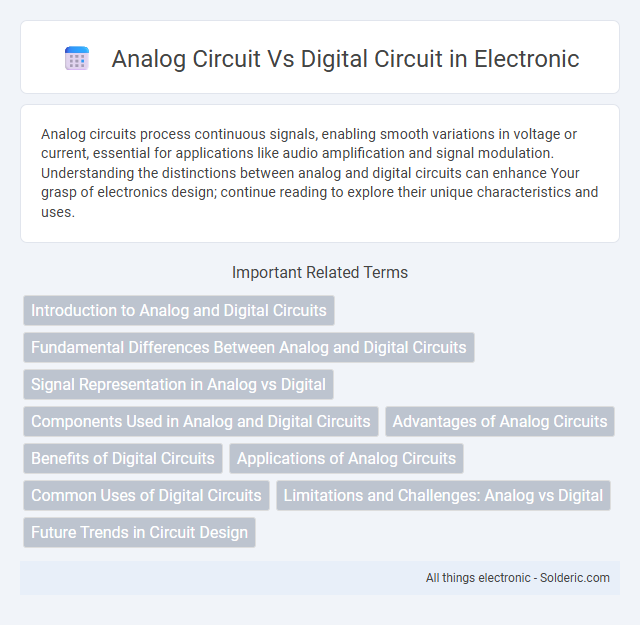Analog circuits process continuous signals, enabling smooth variations in voltage or current, essential for applications like audio amplification and signal modulation. Understanding the distinctions between analog and digital circuits can enhance Your grasp of electronics design; continue reading to explore their unique characteristics and uses.
Comparison Table
| Feature | Analog Circuit | Digital Circuit |
|---|---|---|
| Signal Type | Continuous voltage or current | Discrete binary values (0 and 1) |
| Noise Sensitivity | High, noise affects signal quality | Low, error correction possible |
| Complexity | Simple for small-scale designs | Complex but scalable |
| Precision | Limited by component tolerances | High precision using binary logic |
| Power Consumption | Generally higher | Generally lower |
| Applications | Audio processing, sensor interfaces | Computers, digital communication |
| Speed | Continuous operation speed | Faster switching speed |
| Design Flexibility | Less flexible | Highly flexible, programmable |
Introduction to Analog and Digital Circuits
Analog circuits process continuous signals that vary smoothly over time, accurately representing natural phenomena like sound and light. Digital circuits handle discrete binary signals using logic gates, enabling precise computation and data storage. The fundamental distinction lies in analog circuits' signal continuity versus digital circuits' use of discrete voltage levels for robust and error-resistant operations.
Fundamental Differences Between Analog and Digital Circuits
Analog circuits process continuous signals that vary smoothly over time, representing real-world phenomena with infinite precision, while digital circuits handle discrete binary signals using distinct voltage levels to represent zeros and ones. The fundamental difference lies in signal representation: analog circuits use continuous voltage or current variations, whereas digital circuits rely on quantized digital states for processing and storage. Your choice between analog and digital circuits depends on the specific application requirements, such as precision, noise tolerance, and complexity.
Signal Representation in Analog vs Digital
Analog circuits represent signals as continuous voltage or current waveforms, capturing a full range of values which closely mirror real-world phenomena such as sound or temperature. Digital circuits represent signals using discrete binary levels, typically 0s and 1s, enabling noise-resistant and easily processed information transfer. The continuous nature of analog signals allows for high resolution, while digital signals facilitate error detection and correction through precise quantization.
Components Used in Analog and Digital Circuits
Analog circuits primarily use components such as resistors, capacitors, inductors, diodes, and transistors to process continuous signals, enabling smooth variations in voltage or current. Digital circuits rely on logic gates, flip-flops, microprocessors, and integrated circuits that handle discrete binary signals for precise data manipulation and storage. Understanding the different components in analog and digital circuits helps you design or troubleshoot electronic systems effectively.
Advantages of Analog Circuits
Analog circuits offer superior signal fidelity and continuous waveform processing, making them ideal for audio amplification and radio frequency applications. They consume less power in specific low-frequency operations and provide simpler design for certain sensor interfacing tasks. Their ability to handle infinite signal variations allows for more precise and natural representation of real-world analog signals.
Benefits of Digital Circuits
Digital circuits offer enhanced noise immunity, allowing signals to maintain integrity over longer distances and in electrically noisy environments. They provide high precision and easy programmability, enabling complex computations and reliable data storage. Integration with modern microprocessors and scalability in VLSI technology make digital circuits essential for advanced communication, control systems, and computing devices.
Applications of Analog Circuits
Analog circuits are essential in audio amplification, radio frequency transmission, and sensor signal processing due to their ability to handle continuous signals. They are widely used in applications such as analog audio equipment, temperature sensors, and analog filters for noise reduction. Precision measurement devices and instrumentation also rely heavily on analog circuits for accurate signal representation.
Common Uses of Digital Circuits
Digital circuits are commonly used in computers, smartphones, and digital signal processing systems to handle discrete signals efficiently. They enable precise data storage, processing, and communication in devices such as microcontrollers, calculators, and digital cameras. Your electronic devices rely on digital circuits for reliable operation, accurate computation, and integration with software applications.
Limitations and Challenges: Analog vs Digital
Analog circuits face limitations such as susceptibility to noise, signal degradation over distance, and component variability, making precise manipulation and replication challenging. Digital circuits offer greater noise immunity and easier scalability but encounter challenges like quantization errors, limited resolution, and higher power consumption during high-speed processing. Understanding these constraints helps you select the appropriate circuit type based on application needs and performance requirements.
Future Trends in Circuit Design
Future trends in circuit design emphasize the integration of analog and digital circuits to achieve higher performance and energy efficiency. Advances in mixed-signal ICs enable improved processing capabilities for emerging applications such as IoT, AI, and 5G communication systems. Innovative materials and nanotechnology will further enhance the miniaturization and functionality of both analog and digital circuits, driving the evolution of smart, adaptive electronics.
analog circuit vs digital circuit Infographic

 solderic.com
solderic.com